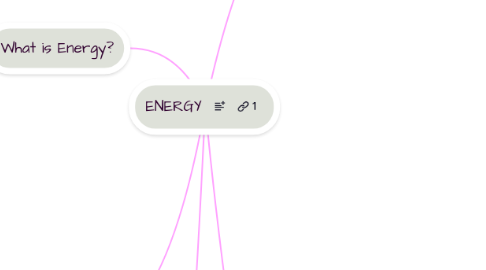
1. What is Energy?
1.1. Energy is the ABILITY TO DO WORK
1.2. Energy can be used either for living or functioning
1.3. S.I. unit for energy: Joule (J)
2. Conserving Energy
2.1. Energy plays a very impostant role in everyday life.
2.2. Rate of energy consumption increases because population & technology development increases as well.
2.3. Fossil Fuels only last for the next 50-70 years. Most energy is supplied by fossil fuels.
3. Sources of Energy
3.1. Renewable Sources
3.1.1. Replenishable in a short period of time due to unlimited supplies or new growth.
3.1.1.1. Solar Energy
3.1.1.1.1. Energy directed from the sun
3.1.1.1.2. Enables plants to make food & animals to live.
3.1.1.1.3. Can be converted to heat & electrical energy.
3.1.1.2. Wind Energy
3.1.1.2.1. Kinetic Energy of wind generates the wind turbines to produce electrical energy.
3.1.1.3. Wave Energy
3.1.1.3.1. Kinetic Energy of waves generate electricity in wave farms.
4. Forms of Energy
4.1. Potential Energy- refers to stored energy due to conditon, a body's position or condition
4.1.1. Chemical Potential Energy
4.1.1.1. Energy stored in fuels and foods, which can be released through chemical reactions.
4.1.2. Gravitational Potential Energy
4.1.2.1. Energy of its position or place.
4.1.2.1.1. HIGHER position with respect to the ground, more GPE than in a LOWER position.
4.1.3. Elastic Potential Energy
4.1.3.1. Energy stored in an object when it is stretched or compressed.
4.2. Kinetic Energy
4.2.1. Energy that an object possesses due to its motion.
4.2.1.1. e.g. All moving objects have kinetic energy.
4.3. Heat
4.3.1. Energy that flows from a region of higher temperature to a region of lower temperature.
4.3.1.1. e.g. HOMES- cooking, heating water & ironing clothes. FACTORIES- melting metals, creating steam to turn turbines & making chemicals react.
4.3.1.2. Transferred by conduction, convection & radiation.
4.4. Light
4.4.1. Energy that enables us to see.
4.4.1.1. Sun is the main source of light energy- plants for photosynthesis.
4.4.1.2. Lumionous objects give out light energy.
4.5. Sound
4.5.1. Energy produced when objects vibrate.
4.5.1.1. USED FOR: communication, entertainment & warnings.
4.6. Electricity
4.6.1. Energy that results from the flow of charged particles.
4.6.1.1. This energy can be transformed into many other forms of energy.
4.6.1.2. Electrical appliances require electricity to work.
5. Energy Transformations
5.1. Works with the concept that one form of energy can change into many other forms of energy.
5.1.1. e.g. PHOTOSYNTHESIS IN PLANTS: Light Energy (from the sun) -> Chemical Potential Energy (starch)
5.1.2. HAIR DRYER: Electrical Energy -> Heat Energy + Sound Energy
5.1.3. RELEASED BOW: Elastic Potential Energy (bow) -> Kinetic Energy (arrow)
5.2. GENERATION OF ELECTRICITY
5.2.1. Electrical generators are used to convert kinetic energy of steam turbines to electricity.
5.2.1.1. Power stations generate this electricity needed in homes, schools & offices. The series of following energy changes take place:
5.2.1.1.1. 1. Fuel is burnt and heat is produced. This causes water in the boiler to boil. Chemical Potential Energy of fuel -> Heat Energy of water
5.2.1.1.2. 2. At high pressure, heat energy turns water to steam. This goes through the boiler which turns the turbines. Potential & Kinetic Energy of steam -> Kinetic Energy of turbines
5.2.1.1.3. 3. A generator, connected to the turbines, converts the kinetic energy of the turbine blades into electricity. Kinetic Energy of turbines -> Electricity
5.2.1.2. Nuclear power stations bombard radioactive elements with neutrons. This causes large amounts of heat to boil water into steam to turn turbines.
